3-D EHD Enhanced Natural Convection over a Horizontal Plate Flow with Optimal Design of a Needle Electrode System
Abstract
:1. Introduction
2. Mathematical Analysis
2.1. Governing Equation
2.1.1. The Electric Field Equations
2.1.2. The Flow Field Equations
2.2. The Heat Transfer Enhancement Per Unit Power Consumption
2.3. Boundary Condition
3. Numerical Method and Optimization
3.1. Numerical Method
3.2. Grid System
3.3. Optimization
- Guess the initial values for the two design variables (x1, x2), the electrode height (H), and the electrode pitch (SL).
- Utilize the finite difference method to solve for the velocity field (U), electric field strength (E), and temperature field (T), and the objective function J(x1, x2) associated with the new values of H and SL.
- When the obtained value of J(x1, x2) a maximum, the optimization search procedure is stopped. Otherwise, continue to Step 4.
- By increasing a small increment (Δx1, Δx2), the gradient functions (∂J/∂x1)(k) and (∂J/∂x2)(k) can be computed using the following algebraic manipulation:
- The conjugate gradient coefficients βc(k) and the search directions ξ1(k + 1) and ξ2(k + 1) can be obtained as follows.
- The new update design variables is calculated as follows:
4. Experimental Facilities and Methods
4.1. Electrode Structure
4.2. Heating Cycle System
4.3. Measuring Section
5. Results and Discussion
6. Conclusions
- The ion-wind effect caused by EHD actually disrupted the flow and enhanced the mixing of the fluids. Therefore, EHD technology can effectively improve heat transfer performance. The heat transfer was increased with increases in the applied voltage.
- The smaller electrode height and the intensive electrode pitch do not give better the heat transfer enhancement per power consumption Eb. The appropriate electrode pitch and height reveal the better benefit on both efficiency and economics. Therefore, the study obtained the optimal combinations of H and SL for specified V0 (V0 = 12, 14, 16, 18, and 20 kV) and ΔT (ΔT = 33, 53 and 73 K) and tabulated in Table 2.
- In the optimization search process with V0 = 12 kV and ΔT = 33 K using SCGM, the maximum value of heat transfer enhancement per power consumption was obtained at the 15th iteration. In addition, using a parametric analysis, the maximum value was obtained at the 806th iteration (15 mm < H < 40 mm take 26 nodes and 50 mm < SL < 200 mm take 31 nodes). Therefore, SCGM is much faster than a parametric analysis.
Author Contributions
Funding
Conflicts of Interest
Nomenclature
| A | heat transfer area, m2 |
| b | ion mobility of air, m2∙V−1∙s−1 |
| E | electric field strength, V∙m−1 |
| Eb | heat transfer enhancement per unit power consumption, W−1 |
| Fe | electric body force, N∙m−3 |
| H | electrode height, m |
| h | average heat transfer coefficient, W∙m−2∙K−1 |
| j | current density, A∙m−2 |
| k | turbulent kinetic energy, J |
| ka | air thermal conductivity, W∙m−1∙K−1 |
| ks | solid thermal conductivity, W∙m−1∙K−1 |
| L | characteristic length, m |
| Lw | the width of plate, m |
| Lx | the length of plate, m |
| n | unit vector normal to the wall, |
| Nu | average Nusselt number |
| NuEHD | average Nusselt number with EHD |
| NunonEHD | average Nusselt number without EHD |
| P | pressure, Pa |
| Pr | turbulent kinetic energy production rate |
| Q | heat flux, W |
| QEHD | heat flux with EHD, W |
| QnonEHD | heat flux without EHD, W |
| SL | electrode pitch, m |
| T∞ | ambient temperature, K |
| Tf | fluid surface temperature, K |
| Tw | wall surface temperature, K |
| ΔT | temperature difference, K (ΔT = Tw − T∞) |
| u,v,w | velocity of air stream along x, y, z coordinates, m∙s−1 |
| Reynold heat flux | |
| Reynold stress | |
| V | applied voltage (electric potential), V |
| WEHD | input power with EHD, W |
| x,y,z | coordinate, m |
| β | volumetric thermal expansion coefficient |
| βc | conjugate gradient coefficient |
| γ | descent direction coefficient |
| ε | turbulent energy dissipation rate, W |
| ε0 | dielectric permittivity, F∙m−1 |
| μ | dynamic viscosity, kg∙m−1∙s−1 |
| μt | turbulence viscosity, kg∙m−1∙s−1 |
| σk | Prandtl number for turbulent kinetic energy |
| σε | Prandtl number for turbulent energy dissipation |
| ρ | density, kg∙m−3 |
| ρc | charge density, C∙m−3 |
| ρc0 | charge density of electrode surface, C∙m−3 |
References
- Marco, S.M.; Velkoff, H.R. Effect of Electrostatic Fields on Free Convection Heat Transfer from Flat Plate. ASME J. Heat Transf. 1963, 63, 9. [Google Scholar]
- O’brien, R.; Shine, A. Some effects of an electric field on heat transfer from a vertical plate in free convection. ASME J. Heat Transf. 1967, 89, 114–116. [Google Scholar] [CrossRef]
- Kibler, K.; Carter, H. Electrocooling in gases. J. Appl. Phys. 1974, 45, 4436–4440. [Google Scholar] [CrossRef]
- Franke, M.; Hogue, L. Electrostatic cooling of a horizontal cylinder. ASME Trans. J. Heat Transf. 1991, 113, 544–548. [Google Scholar] [CrossRef]
- Owsenek, B.L.; Seyed-Yagoobi, J.; Page, R.H. Experimental investigation of corona wind heat transfer enhancement with a heated horizontal flat plate. J. Heat Transf. 1995, 117, 309–315. [Google Scholar] [CrossRef]
- Owsenek, B.L.; Seyed-Yagoobi, J. Theoretical and experimental study of electrohydrodynamic heat transfer enhancement through wire-plate corona discharge. J. Heat Transf. 1997, 119, 604–610. [Google Scholar] [CrossRef]
- Bhattacharyya, S.; Peterson, A. Corona Wind-Augmented Natural Convection-part 1: Single Electrode Studies. J. Enhanc. Heat Transf. 2002, 9, 209–219. [Google Scholar] [CrossRef]
- Huang, R.T.; Sheu, W.J.; Wang, C.C. Heat transfer enhancement by needle-arrayed electrodes—An EHD integrated cooling system. Energy Convers. Manag. 2009, 50, 1789–1796. [Google Scholar] [CrossRef]
- Go, D.B.; Garimella, S.V. Fisher, T.S.; Mongia, R.K. Ionic winds for locally enhanced cooling. J. Appl. Phys. 2007, 102, 053302. [Google Scholar] [CrossRef]
- Jewell-Larsen, E.N.; Ran, H.; Zhang, Y.; Schwiebert, M.K.; Honer Tessera, K.A. Electrohydrodynamic (EHD) cooled laptop. In Proceedings of the IEEE 25th SEMI-THERM, San Jose, CA, USA, 15–19 March 2009; pp. 261–266. [Google Scholar]
- Shakouri, P.M.; Esmaeilzadeh, E. Experimental investigation of convective heat transfer enhancement from 3D-shape heat sources by EHD actuator in duct flow. Exp. Therm. Fluid Sci. 2011, 35, 1383–1391. [Google Scholar] [CrossRef]
- Peng, M.; Wang, T.H.; Wang, X.D. Effect of longitudinal electrode arrangement on EHD-induced heat transfer enhancement in a rectangular channel. Int. J. Heat Mass Transf. 2016, 93, 1072–1081. [Google Scholar] [CrossRef]
- Heidarinejad, G.; Babaei, R. Numerical investigation of electro hydrodynamics (EHD) enhanced water evaporation using Large Eddy Simulation turbulent model. J. Electrost. 2015, 77, 76–87. [Google Scholar] [CrossRef]
- Leu, J.S.; Jang, J.Y.; Wu, Y.-H. Optimization of the wire electrode height and pitch for 3-D electrohydrodynamic enhanced water evaporation. Int. J. Heat Mass Transf. 2018, 118, 976–988. [Google Scholar] [CrossRef]
- Lai, F.C.; Sharma, R.K. EHD-enhanced drying with multiple needle electrode. J. Electrost. 2005, 63, 223–237. [Google Scholar] [CrossRef]
- Lin, C.W.; Jang, J.Y. 3D Numerical heat transfer and fluid flow analysis in plate-fin and tube heat exchangers with electrohydrodynamic enhancement. Heat Mass Transf. 2005, 41, 583–593. [Google Scholar] [CrossRef]
- CFD-ACE(U); CFD Research Corporation: Huntsville, AL, USA, 2013.
- Quarteroni, A.; Sacco, R.; Saleri, F. Numerical Mathematics; Springer: New York, NY, USA, 2007. [Google Scholar]
- Launder, B.E.; Spalding, D.B. The Numerical Computation of Turbulent Flows. Comput. Methods Appl. Mech. Eng. 1974, 3, 269–289. [Google Scholar] [CrossRef]
- Liakopoulos, A. Explicit representation of the complete velocity profile in a turbulent boundary layer. AIAA J. 1984, 22, 844–846. [Google Scholar] [CrossRef]
- Kline, S.J.; McClintock, F.A. Describing uncertainties single-sample experiments. ASME Mech. Eng. 1953, 75, 3–8. [Google Scholar]
- Wang, T.H.; Peng, M.; Wang, X.D.; Yan, W.M. Investigation of heat transfer enhancement by electrohydrodynamics in a double-wall-heated channel. Int. J. Heat Mass Transf. 2017, 113, 373–383. [Google Scholar] [CrossRef]



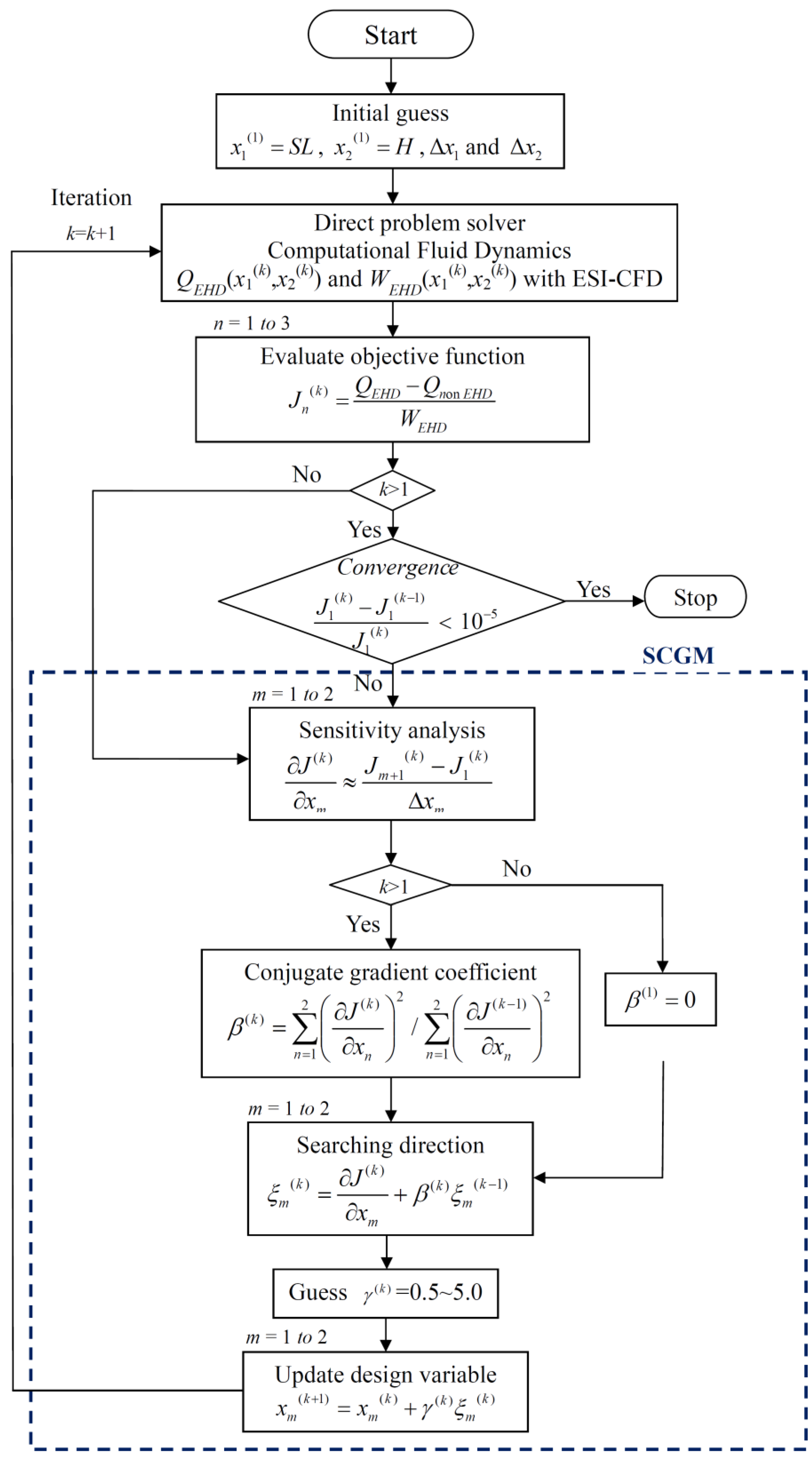
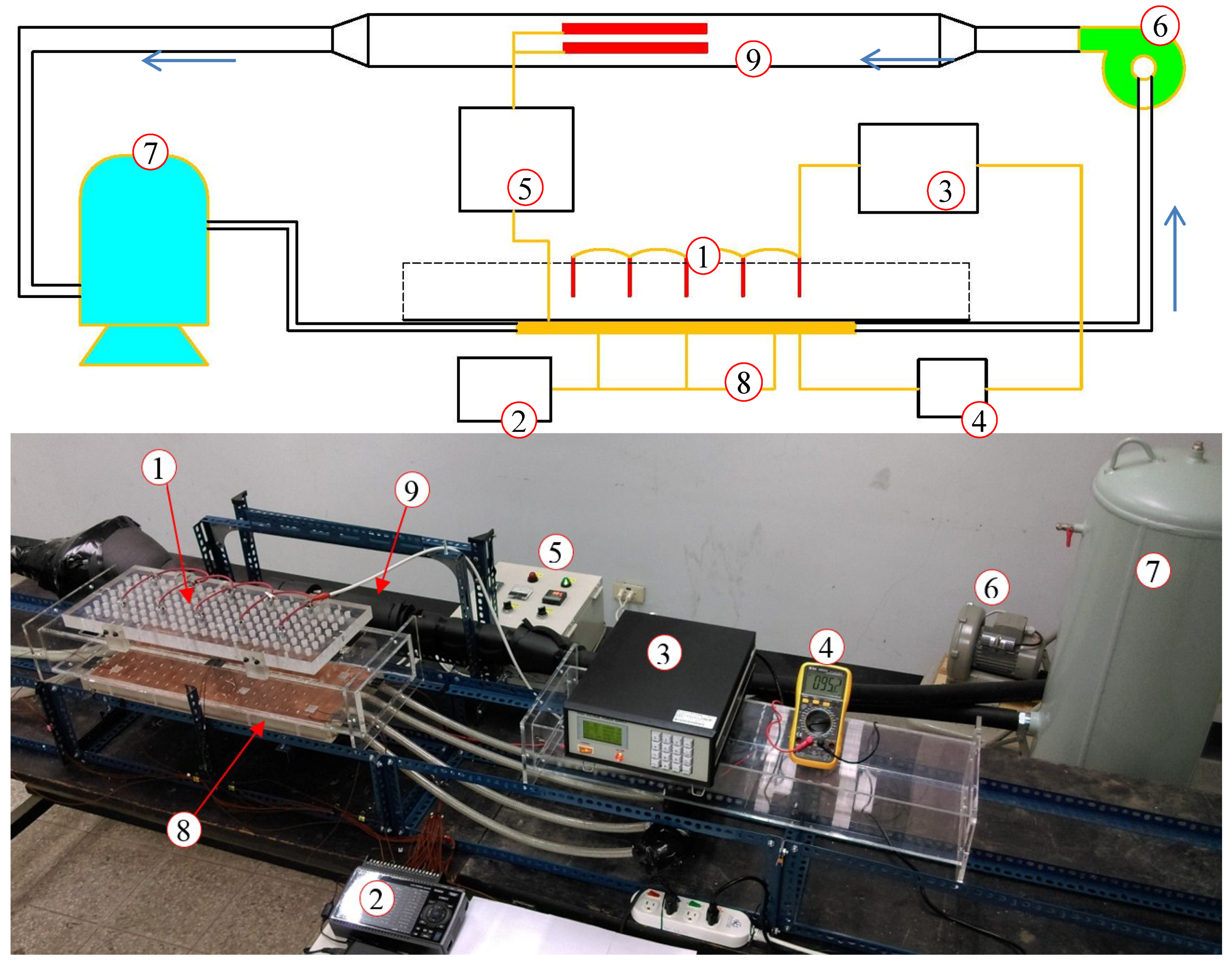

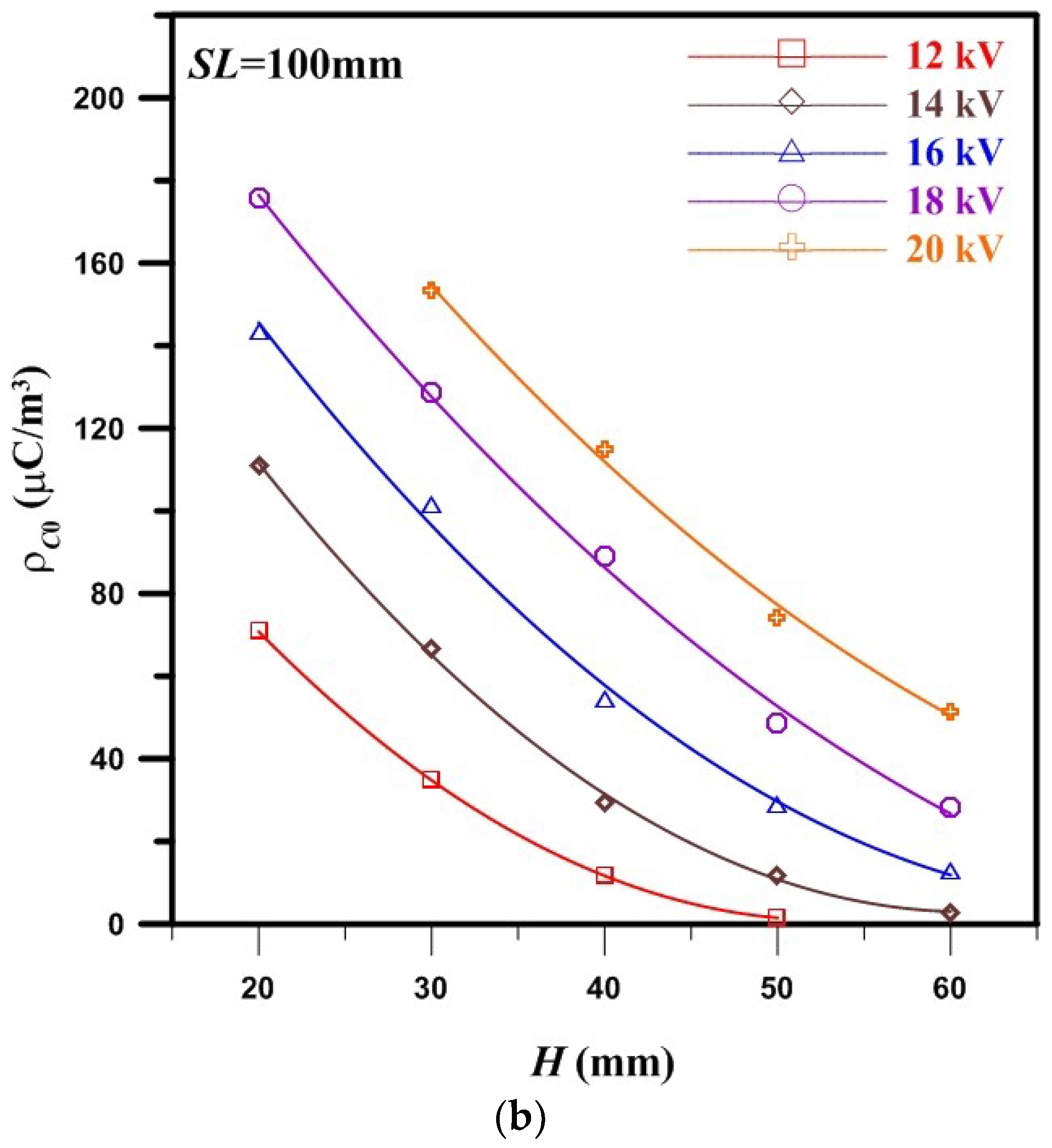
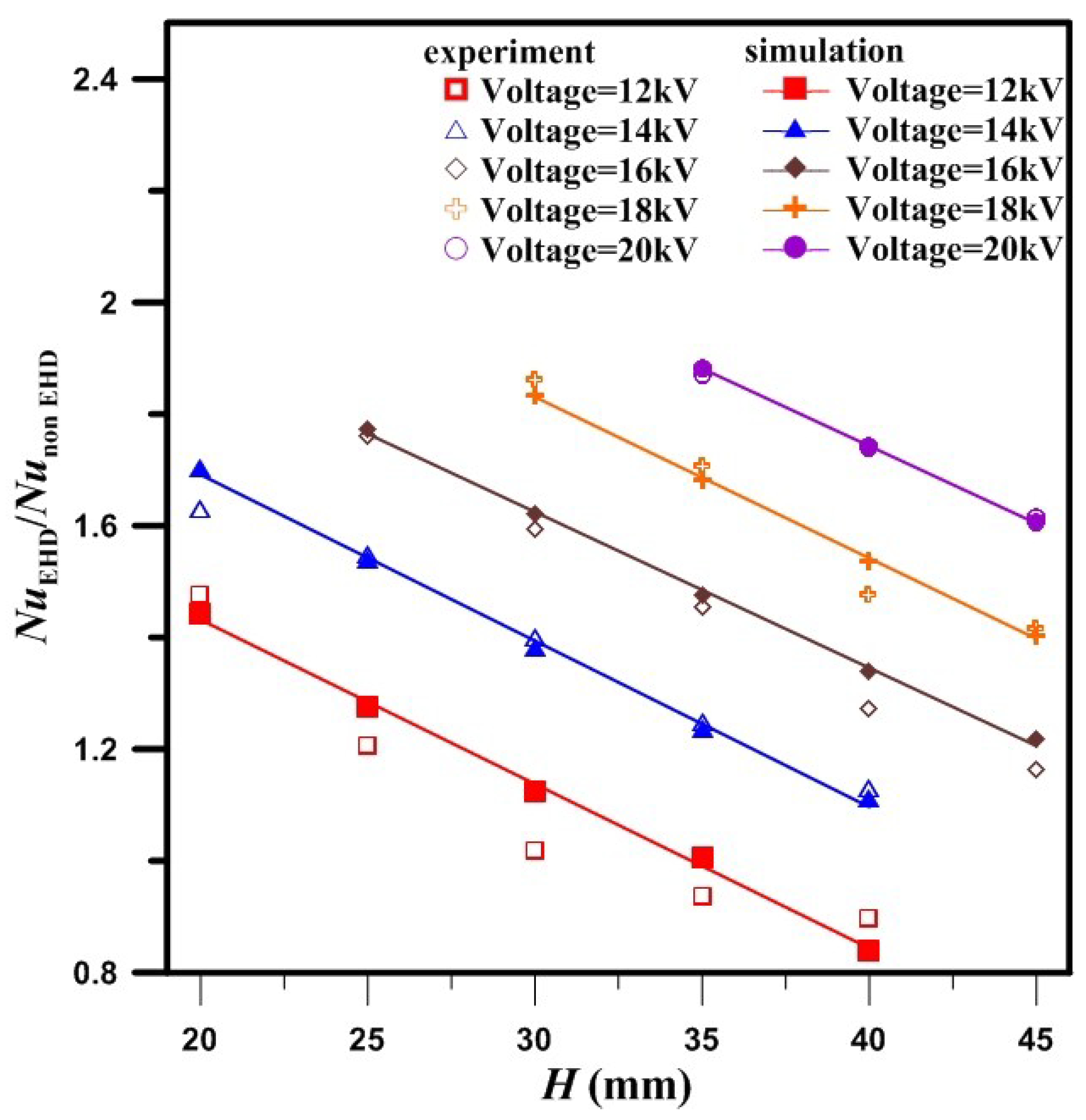
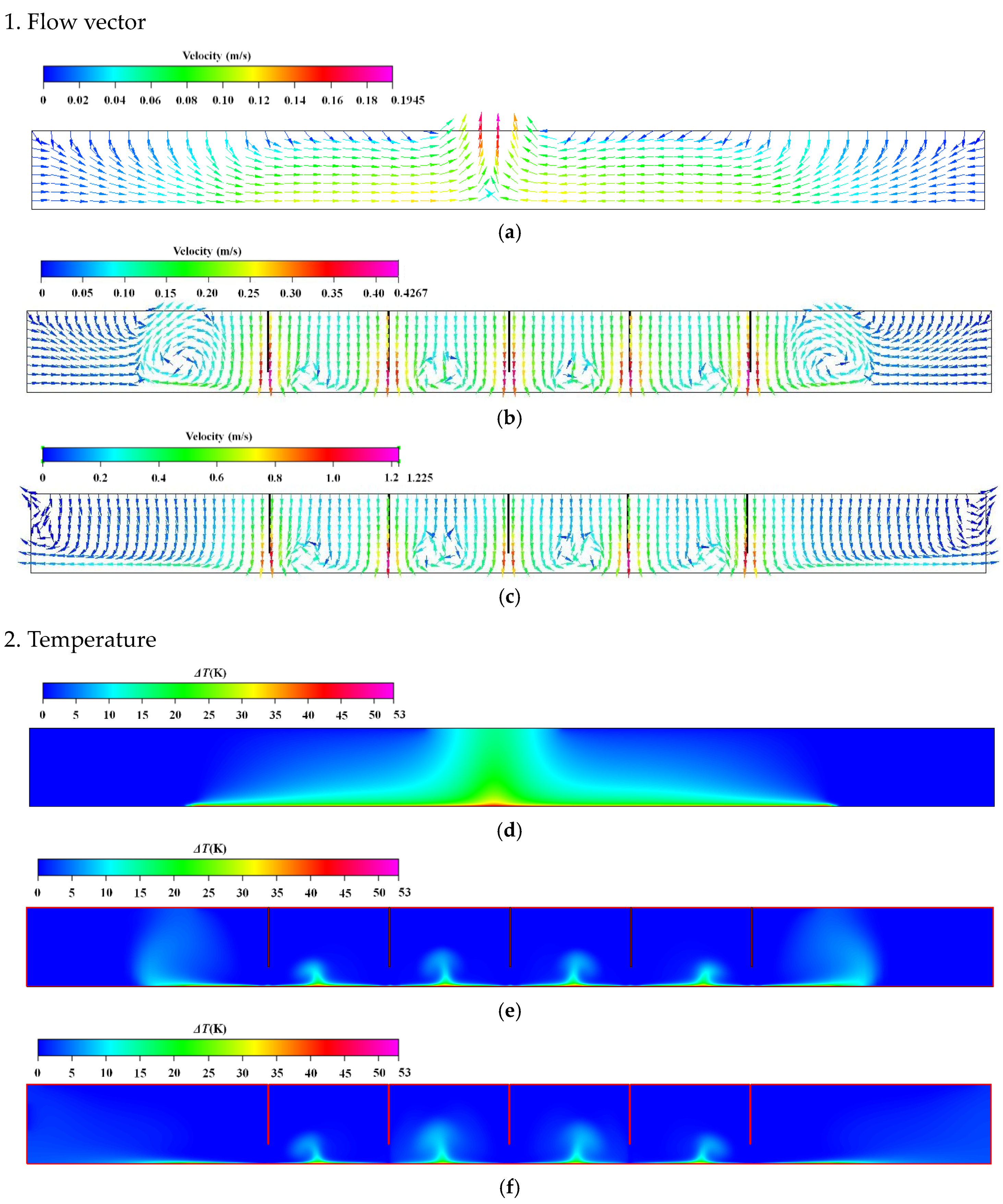
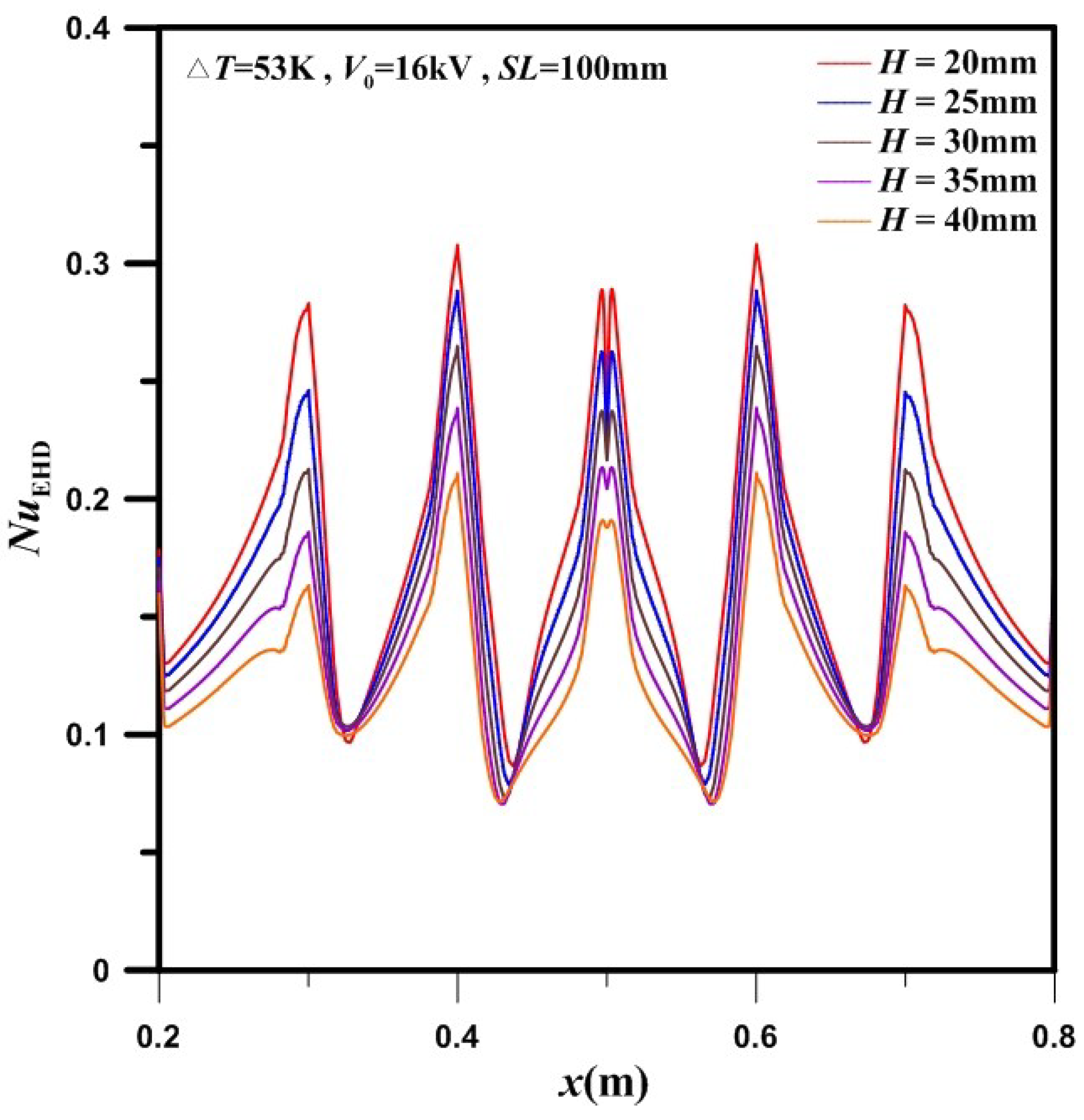
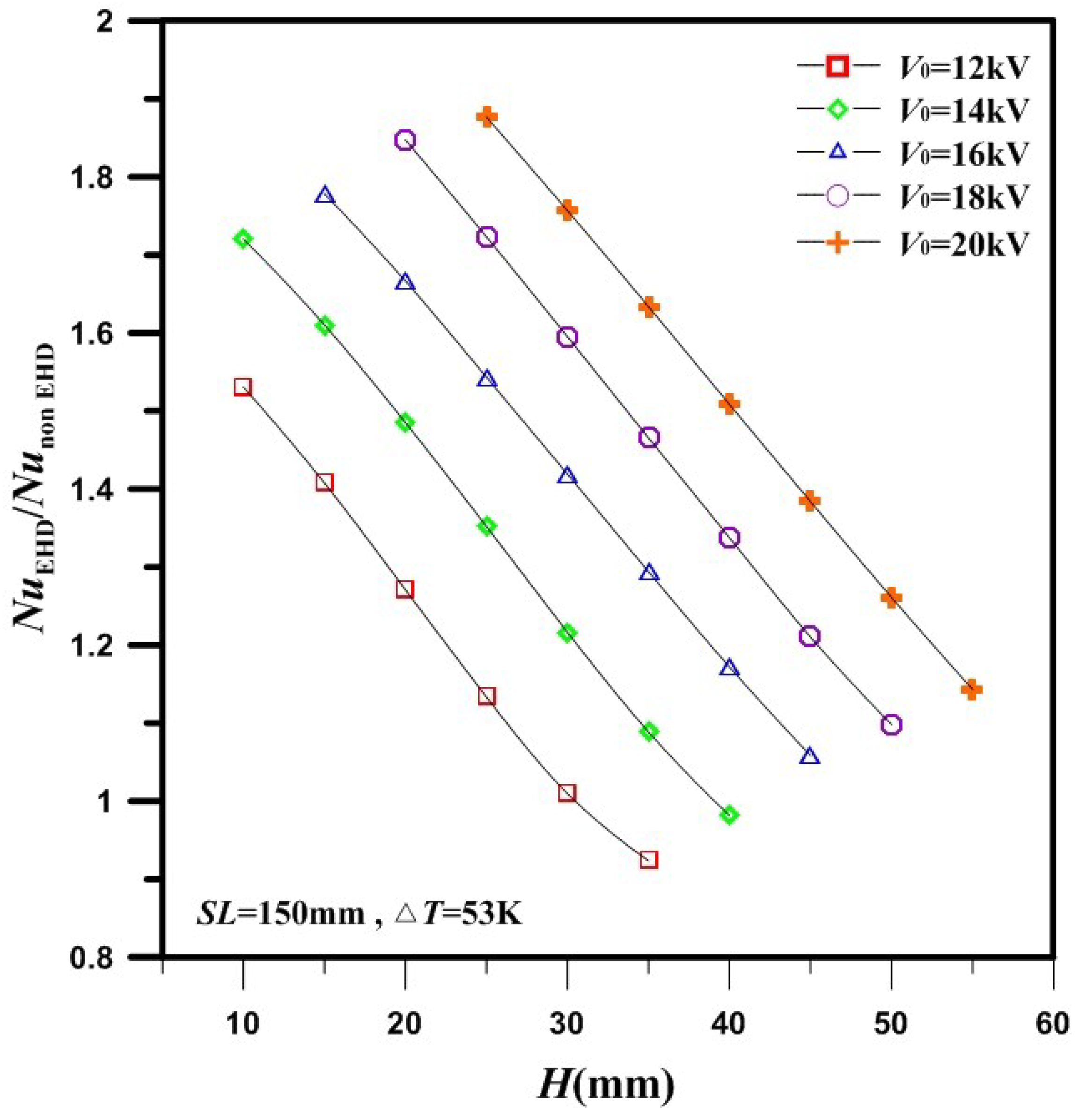
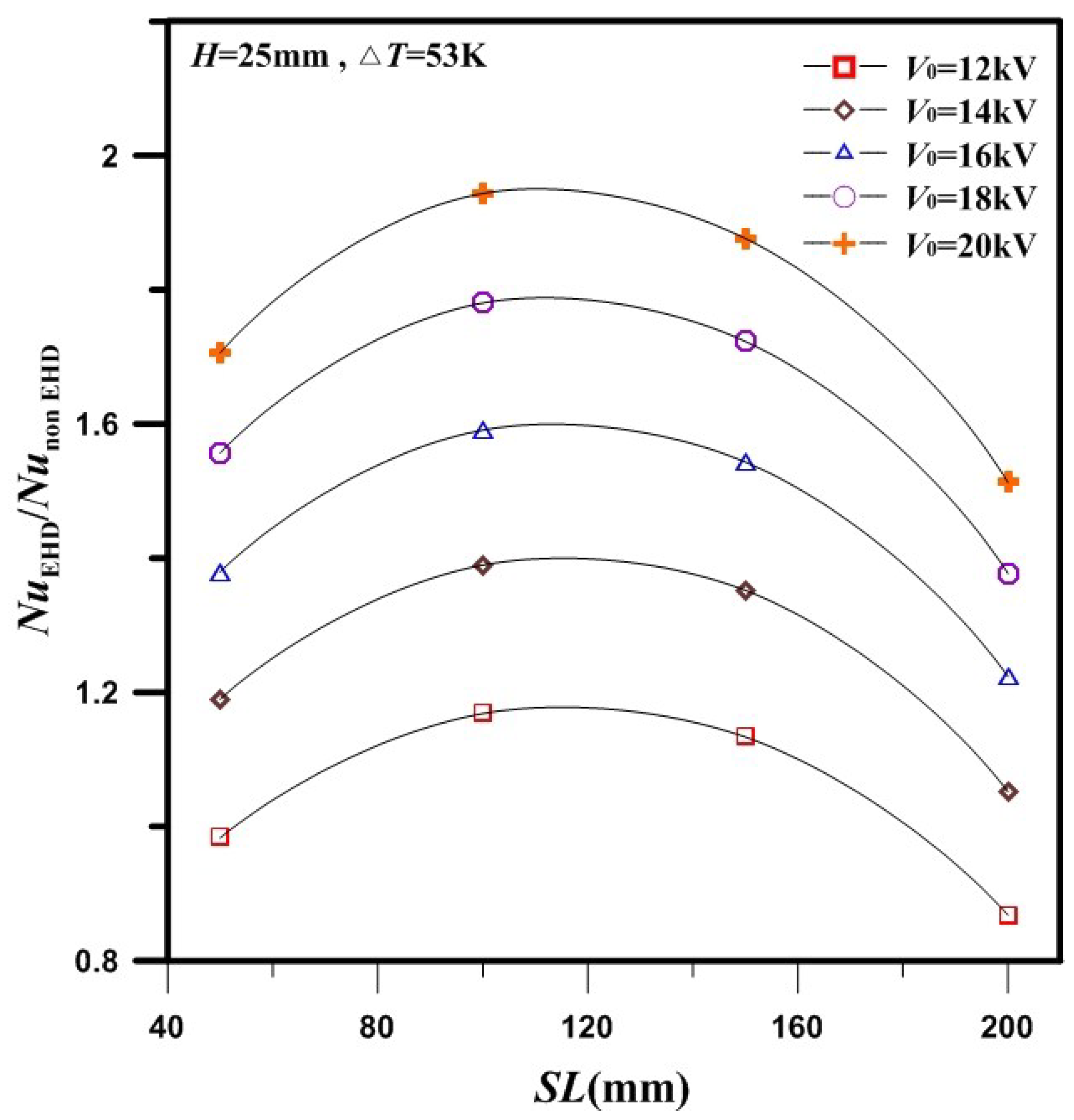

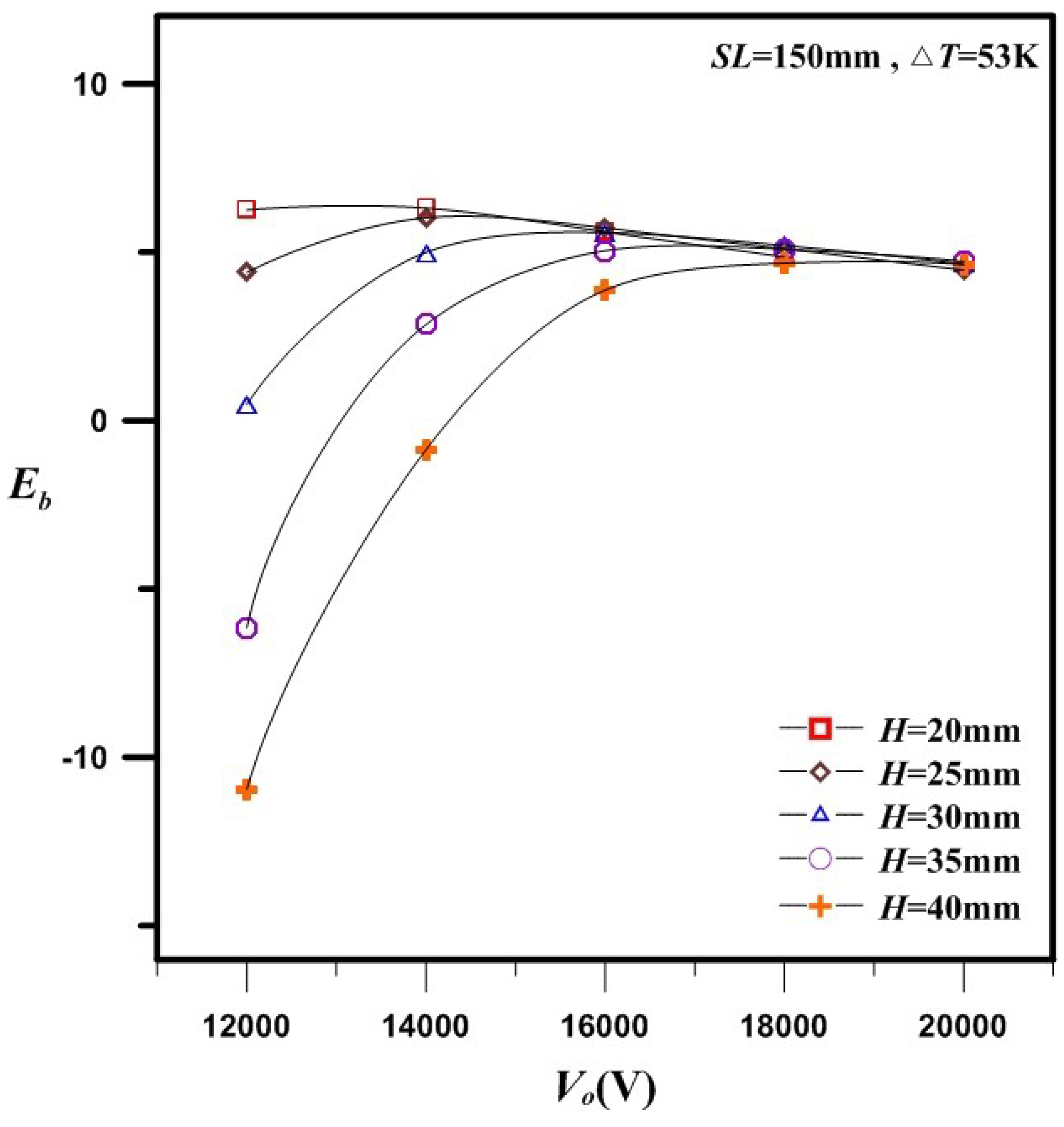

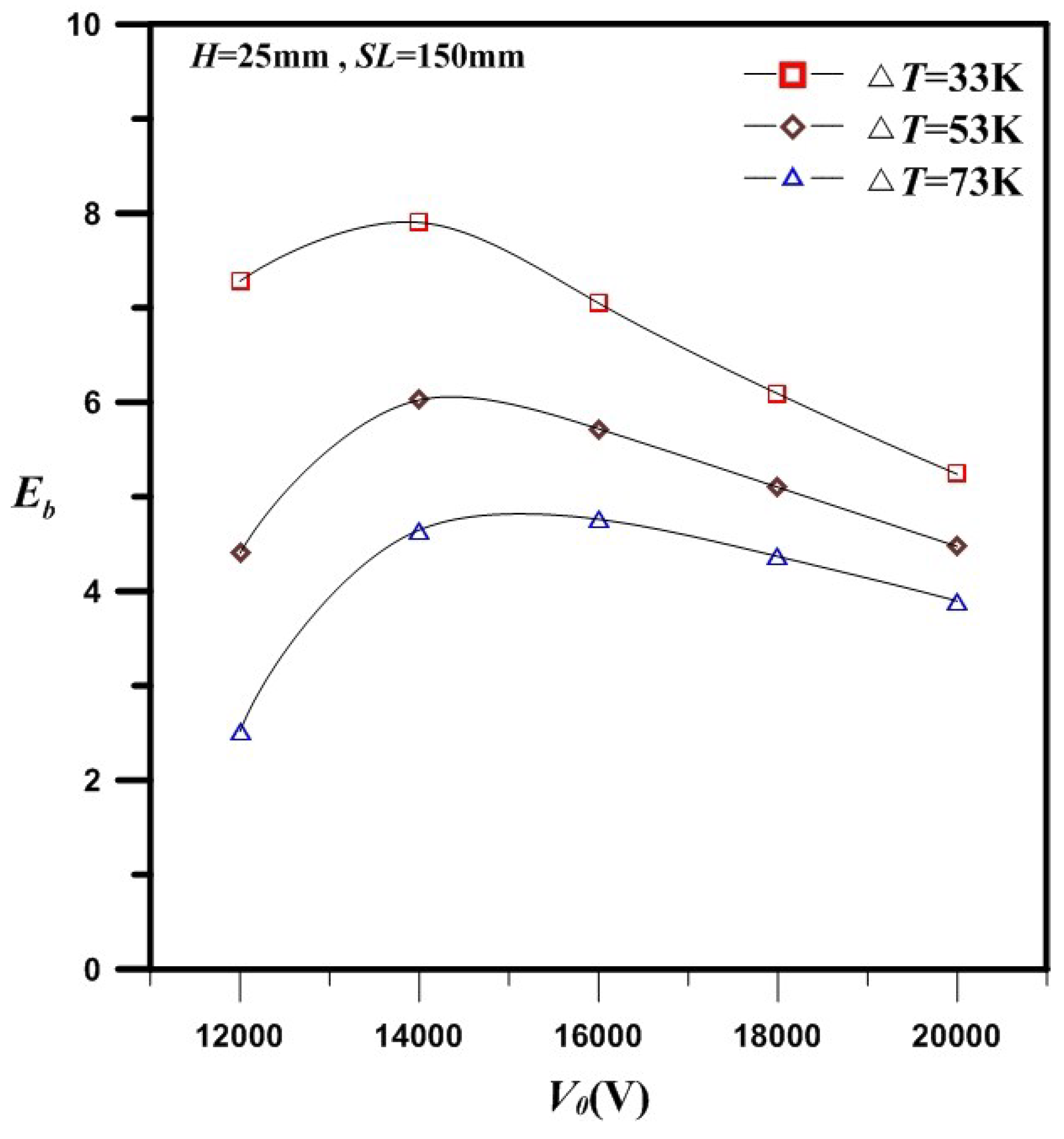
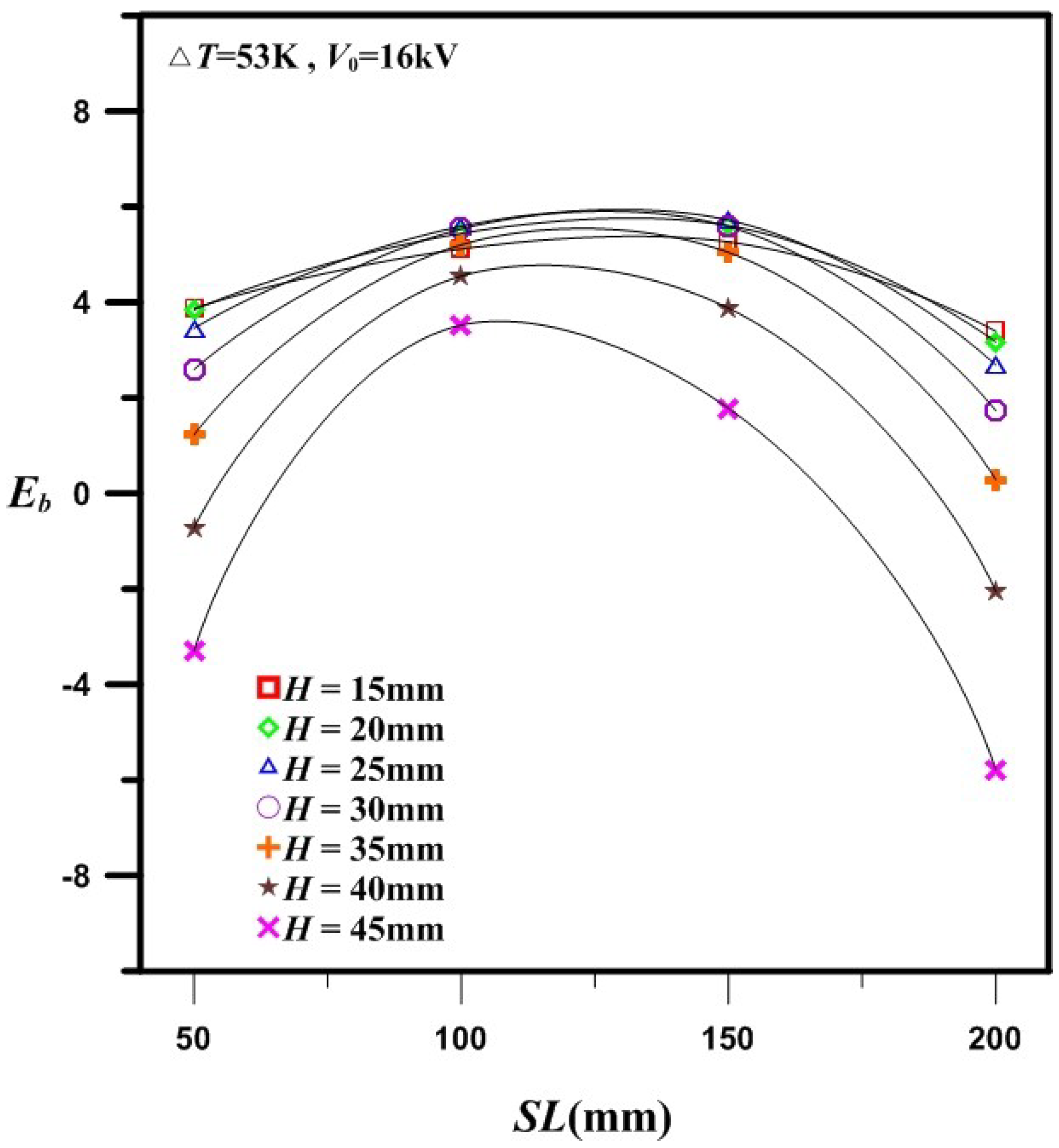
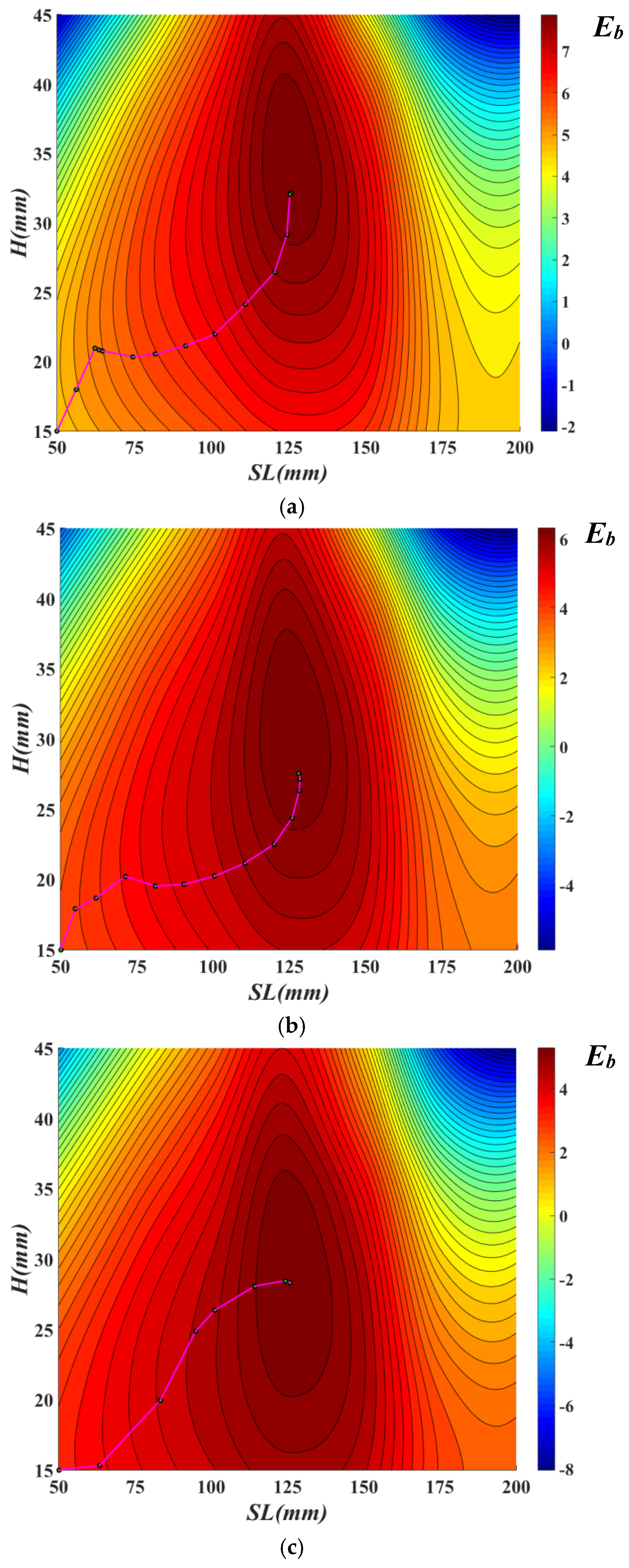
| Primary Measurement | Derived Measurement | ||
|---|---|---|---|
| Parameter | Uncertainties | Parameter | Uncertainties |
| V0 = 16 kV | |||
| V0 | 2% | Nu | 4.1% |
| I | 0.5% | Eb | 4.5% |
| T∞ | 0.1 °C | - | - |
| Tw | 0.1 °C | - | - |
| V0 (kV) | H (mm) | SL (mm) | Eb (1/W) | Iteration No. |
|---|---|---|---|---|
| (a) ΔT = 33 K | - | - | - | - |
| 12 | 17.7 | 127.0 | 9.72 | 15 |
| 14 | 24.2 | 126.5 | 8.78 | 19 |
| 16 | 32.2 | 125.8 | 7.96 | 14 |
| 18 | 38.2 | 125.9 | 7.19 | 15 |
| 20 | 45.6 | 129.4 | 6.41 | 19 |
| (b) ΔT = 53 K | - | - | - | - |
| 12 | 19.3 | 126.9 | 7.81 | 14 |
| 14 | 22.6 | 126.7 | 7.08 | 23 |
| 16 | 27.5 | 128.2 | 6.36 | 13 |
| 18 | 33.8 | 128.2 | 5.79 | 16 |
| 20 | 37.4 | 127.2 | 5.26 | 12 |
| (c) ΔT = 73 K | - | - | - | - |
| 12 | 16.8 | 123.1 | 6.39 | 16 |
| 14 | 17.6 | 130.6 | 7.77 | 12 |
| 16 | 28.3 | 125.9 | 5.50 | 8 |
| 18 | 29.5 | 128.6 | 4.92 | 17 |
| 20 | 34.1 | 130.9 | 4.42 | 21 |
© 2018 by the authors. Licensee MDPI, Basel, Switzerland. This article is an open access article distributed under the terms and conditions of the Creative Commons Attribution (CC BY) license (http://creativecommons.org/licenses/by/4.0/).
Share and Cite
Jang, J.-Y.; Chen, C.-C. 3-D EHD Enhanced Natural Convection over a Horizontal Plate Flow with Optimal Design of a Needle Electrode System. Energies 2018, 11, 1670. https://doi.org/10.3390/en11071670
Jang J-Y, Chen C-C. 3-D EHD Enhanced Natural Convection over a Horizontal Plate Flow with Optimal Design of a Needle Electrode System. Energies. 2018; 11(7):1670. https://doi.org/10.3390/en11071670
Chicago/Turabian StyleJang, Jiin-Yuh, and Chun-Chung Chen. 2018. "3-D EHD Enhanced Natural Convection over a Horizontal Plate Flow with Optimal Design of a Needle Electrode System" Energies 11, no. 7: 1670. https://doi.org/10.3390/en11071670




